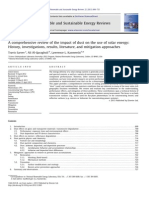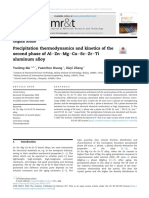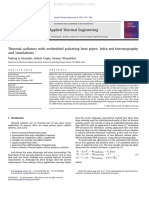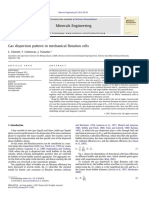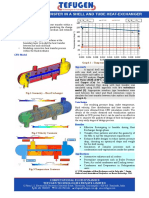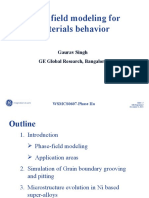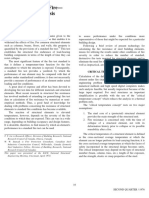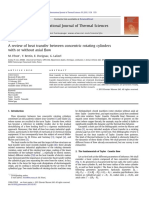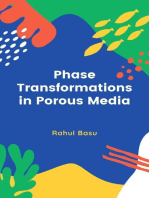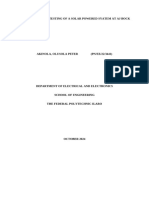Tolerable Settlement of Buildings
Tolerable Settlement of Buildings
Uploaded by
amokhtaCopyright:
Available Formats
Tolerable Settlement of Buildings
Tolerable Settlement of Buildings
Uploaded by
amokhtaOriginal Description:
Copyright
Available Formats
Share this document
Did you find this document useful?
Is this content inappropriate?
Copyright:
Available Formats
Tolerable Settlement of Buildings
Tolerable Settlement of Buildings
Uploaded by
amokhtaCopyright:
Available Formats
Advanced Analysis of
Thermal Energy Storage Systems in CSP Plants
C.D. Pérez-Segarra, I. González, S. Torras, J. Rigola, A. Oliva
Heat and Mass Transfer Technological Centre, (CTTC) Universitat Politecnica de Catalunya (UPC-BarcelonaTech)
An efficient numerical simulation platform has been developed in order to test the thermo-mechanical performance of
different Thermal Energy Storage systems: two-tank and single-thermocline tank. A parallel object-oriented code solves and
couples all the components of the system by considering the heat transfer, fluid dynamics and thermoelastic phenomena
involved. Having proved its validity with experimental cases, CTTC-UPC has carried out valuable studies on TES focused on
the transient annual storage response, parametric analysis, optimal tank sizing, structural integrity, phase change materials,
multi-layered solid-PCM, etc.
Two-Tank Storage
Mathematical fomrulations and physical phenomena Thermo-fluid dynamics performance
Multi-physic nature of the system: 3D turbulent Transient evolution of the: (a)
currents of the molten salt, 3D conduction heat molten salt temperature in the
transfer (tank walls, insulation, foundation, etc.), hot tank for four different
thermal radiation inside the tanks and with the geographical locations; (b) total
external ambient, passive cooling in the foundation, heat losses in the molten salt for
mechanical and thermal stresses, unsteady behaviour, different insulation thickness.
gas ullage, etc. A modular object-oriented metho- (a) (b)
dology has been developed: STEScode.
Multi-scale phenomena: advanced CFD analysis using
LES turbulence models (see instantaneous streamlines
below).
Design aspects: thermal losses control; optimization of FDN 1 (NREL foundation) FDN 2 (Arlita foundation)
Comparison of two
the storage (cost reduction); how to scale up
different foundations
(FDN 1 and FDN 2)
located in Sevilla.
Temperature field (a) (a)
distribution in the
Reference study case Storage tank internal and radii,
12 m and 12.205 m, respectively. foundation after 7
months (a), and
Detailed analysis of the hot
Foundation thicknesses (FDN 1): after 43 months of
tank behaviour under the
dry sand, e1 = 0.006 m; foam- operation (starting
specific conditions given in the
glass, e2 = 0.420 m; heavy weight January 1st) (b) (b)
table.
concrete, e3 = 0.450 m; soil, e4 =
The cooling-down process of 9.140 m.
the hot (Tms= 565 ºC) and cold
(Tms=290 ºC) storage tanks is Foundation thicknesses (FDN 2):
also considered. dry sand, e1= 0.04 m; arlita, e2=
1.86 m; concrete, e= 0.450 m; dry Table: heat and cost Heat loss Foundation materials
sand, e= 0.30 m; reduction of FDN 2 Reduction cost reduction
soil, e= 7.35 m. respect to FDN 1 27.5 % 16.3 %
Multi-Layered Thermocline Storage
Mathematical & Numerical model Thermo-mechanical performance
Different thermocline storage concepts Plant configuration
Packed-bed 𝑊𝑊̇𝐸𝐸𝐸𝐸 = 50 MWe
Encapsulated phase change material (PCM) ∆𝑇𝑇 = 390 ºC – 290 ºC
Multi-layered solid-PCM 𝐴𝐴𝑆𝑆𝑆𝑆 = 510,120 m2
Dynamic coupling of all system elements by means of a parallel object-
oriented code (NEST). Mass, momentum and energy balances are
solved and discretized with Finite Volume numerical method. A Features Pure thermocline Multi-layered solid-PCM
modular object-oriented methodology has been developed: LTEScode. Diameter x Height 43.7 m x 13 m 43.7 m x 13 m
Fluid and filler material Storage capacity 970 MWh / 6.9 h 1190 MWh / 8.6 h
One-dimensionality in the fluid flow (axial direction) and in the heat Thermal efficiency 80.3 % 92.9 %
transfer inside particles (radial distribution).
Mass confined 38,020 ton rock 34,220 ton rock
Heat conduction considering molecular diffusion and thermal
dispersion. 8,040 ton molten salt 8,700 ton molten salt
Thermal losses through lateral walls and top and bottom surfaces. 0 ton PCM 1,720 ton PCM
Tank-wall stresses
3D-thermoelastic model for the wall.
Bulk solid active-passive pressures with particle settlement and
thermal expansion. Temperature maps during
Model validation an average discharge
Transient evolution of pure-
thermocline gradient
height
Transient evolution of pure-
thermocline equivalent
Numerical results (solid lines) vs. experimental Tank-wall hoop stresses during a day-cycle of stress at h = 7m
results from Pacheco et al. (points). Solar One Pilot Plant thermocline tank.
Conclusions References Acknowledgements
Validated numerical simulation tools for the thermal, fluid dynamic and thermoelastic analysis of two of the most important TES systems: the [1] I.Rodríguez, C.D.Pérez-Segarra, O.Lehmkuhl, A.Oliva. Modular object-oriented methodology This work has been supported by the
two-tank system and the thermocline system. They have been developed and used for design and performance evaluation purposes. Parameters for the resolution of molten salt storage tanks for CSP plants. Applied Energy 2013; 109:402-414 Ministerio de Economía y Competitividad,
such as meteorological data, insulation, foundation, tank geometry or operating conditions can be modified, and variables like dynamic
temperature maps, thermal losses, energy exchanges, efficiencies, thermal stresses or structural safety factors can be measured. [2] P.A. Galione, C.D.Pérez-Segarra, I.Rodríguez, S.Torras, J.Rigola. Multi-layered solid-PCM Secretaría de Estado de Investigación,
thermocline thermal storage for CSP. Numerical evaluation of its application in a 50 MWe plant. Desarrollo e Innovación, Spain (ENE-2014-
A new multi-layered solid-PCM thermocline-like thermal storage concept for CSP plants has been presented. It prevents the degradation of the
Solar Energy 2015; 119:134-150. 60577-R) and by the EIT through the KIC
thermocline occurring in the pure thermocline and leads to a higher efficiency in the use of the overall storage capacity.
Suitable structural factors of safety, which assure structural integrity throughout the storage tank service life, can be achieved with a proper [3] I.González, C.D.Pérez-Segarra, O.Lehmkuhl, S.Torras, O.Oliva. Thermo-mechanical parametric InnoEnergy Tesconsol project (Ref.
design. analysis of packed-bed thermocline energy storage tanks. Applied Energy 2016; 179:1106-1122. 20_2011_IP16).
You might also like
- A Comprehensive Review of The Impact of Dust On The Use of Solar EnergyDocument36 pagesA Comprehensive Review of The Impact of Dust On The Use of Solar EnergyGugui68No ratings yet
- 1 s2.0 S0009250921000853 MainDocument13 pages1 s2.0 S0009250921000853 MainGanjar GilaNo ratings yet
- CHE F241 HT Course Handout - AfkhamDocument2 pagesCHE F241 HT Course Handout - AfkhamAzureNo ratings yet
- Control of An Exothermic Packed-Bed Tubular ReactorDocument6 pagesControl of An Exothermic Packed-Bed Tubular Reactorکبری ادریس رسولNo ratings yet
- ICONE20-POWER2012-54612: Three-Dimensional Numerical Study On Condensation-Conduction-Evaporation Coupled Heat TransferDocument4 pagesICONE20-POWER2012-54612: Three-Dimensional Numerical Study On Condensation-Conduction-Evaporation Coupled Heat TransferSasank KomarlaNo ratings yet
- F. de Rossi, A.W. Mauro, M. Musto, G.P. Vanoli: ArticleinfoDocument10 pagesF. de Rossi, A.W. Mauro, M. Musto, G.P. Vanoli: ArticleinfoFrancisco OppsNo ratings yet
- The Application of Two Dimensional X Ray Hot Stage in Flip Chip Package Failure AnalysisDocument7 pagesThe Application of Two Dimensional X Ray Hot Stage in Flip Chip Package Failure AnalysismrbustaNo ratings yet
- Thermal Response Test Numerical Modeling Using A Dynamic SimulatorDocument12 pagesThermal Response Test Numerical Modeling Using A Dynamic SimulatorcindyNo ratings yet
- 1 s2.0 S223878542032041X MainDocument8 pages1 s2.0 S223878542032041X Mainwangbei.fightNo ratings yet
- Wang Et Al. - 2012 - Finite Element Simulation of Stress Distribution and Development in 8YSZ and Double-Ceramic-Layer La 2Zr 2O 78YSZ TDocument12 pagesWang Et Al. - 2012 - Finite Element Simulation of Stress Distribution and Development in 8YSZ and Double-Ceramic-Layer La 2Zr 2O 78YSZ TMayank Balu GhugretkarNo ratings yet
- D'esposito 2017 Thermal PenetrationDocument5 pagesD'esposito 2017 Thermal PenetrationFajar AnggaraNo ratings yet
- 1 s2.0 S0960148118305287 MainDocument15 pages1 s2.0 S0960148118305287 Mainmeow1989No ratings yet
- Stiffness of Saflex® Structural InterlayerDocument2 pagesStiffness of Saflex® Structural InterlayerjeanpierreNo ratings yet
- A Thermal Benchmark Chip: Design and ApplicationsDocument7 pagesA Thermal Benchmark Chip: Design and ApplicationsnidhalNo ratings yet
- Hemadri 2011Document15 pagesHemadri 2011Vadiraj HemadriNo ratings yet
- In-Situ Mapping of Local Orientation and Strain in A Fully Operable Infrared SensorDocument9 pagesIn-Situ Mapping of Local Orientation and Strain in A Fully Operable Infrared SensorSITI FARHANA ABDUL RAOFNo ratings yet
- 8 Consumed Creep Life FractionDocument7 pages8 Consumed Creep Life FractionAlok SinghNo ratings yet
- Hedayatizade 2020Document9 pagesHedayatizade 2020Clemen AlarconNo ratings yet
- A Numerical and Three-Dimensional Analysis of Steady State Rectangular Natural Circulation LoopDocument12 pagesA Numerical and Three-Dimensional Analysis of Steady State Rectangular Natural Circulation LoopGanjar GilaNo ratings yet
- Co Simulation2023Document19 pagesCo Simulation2023karamanbe20No ratings yet
- 2017 - Review of Nature-Inspired Heat Exchanger TechnologyDocument17 pages2017 - Review of Nature-Inspired Heat Exchanger TechnologyCarlos Fernando Rojas TovarNo ratings yet
- Airflow Heat Transfer DSF PDFDocument7 pagesAirflow Heat Transfer DSF PDFThao NguyenNo ratings yet
- Ab Initio Prediction of Elastic and Thermal Properties of Cubic TiO2Document6 pagesAb Initio Prediction of Elastic and Thermal Properties of Cubic TiO2Haibing ZhangNo ratings yet
- bs01 0931 938Document8 pagesbs01 0931 938MARIVEL BASANo ratings yet
- Minerals Engineering: L. Vinnett, F. Contreras, J. YianatosDocument6 pagesMinerals Engineering: L. Vinnett, F. Contreras, J. YianatosCatalinaSoledadBelloCarrascoNo ratings yet
- Gori 2008Document8 pagesGori 2008sami samNo ratings yet
- ICONE12-49360: Analysis of A Convection Loop For GFR Post-Loca Decay Heat RemovalDocument10 pagesICONE12-49360: Analysis of A Convection Loop For GFR Post-Loca Decay Heat RemovalgweschuckNo ratings yet
- Tefugen Resources Heat Exchanger1Document1 pageTefugen Resources Heat Exchanger1Christiano ElondoNo ratings yet
- Simulation Thermal Behaviour of Concrete by FEA A STAR Review (ICT Newsletter)Document1 pageSimulation Thermal Behaviour of Concrete by FEA A STAR Review (ICT Newsletter)s80johnnyNo ratings yet
- Thermal Response Time of Media in Heat Assisted Magnetic RecordingDocument8 pagesThermal Response Time of Media in Heat Assisted Magnetic RecordingMaileth Carolina Anillo ArrietaNo ratings yet
- 2017 - An Improved Prediction of Residual Stresses and Dist - 2017 - Computational MateDocument13 pages2017 - An Improved Prediction of Residual Stresses and Dist - 2017 - Computational MateSachin SinghNo ratings yet
- 1 s2.0 S0263823123008443 MainDocument16 pages1 s2.0 S0263823123008443 Mainrstar78934No ratings yet
- Plan of Lectures 201 FallDocument2 pagesPlan of Lectures 201 FalladityaNo ratings yet
- A Thermo-Elastic Annular Plate Model For The Modeling of Brake SystemsDocument10 pagesA Thermo-Elastic Annular Plate Model For The Modeling of Brake SystemsSathish KumarNo ratings yet
- Ansys Workbench Moisture-And-CreepDocument23 pagesAnsys Workbench Moisture-And-CreepzhouflNo ratings yet
- DivertorDocument18 pagesDivertordebjyotibasu.basuNo ratings yet
- 1 s2.0 S0011227512002226 MainDocument8 pages1 s2.0 S0011227512002226 MainmateuszNo ratings yet
- Phase Field Modeling For Materials Behavior: Gaurav Singh GE Global Research, BangaloreDocument46 pagesPhase Field Modeling For Materials Behavior: Gaurav Singh GE Global Research, BangaloreGaurav SinghNo ratings yet
- A Large-Gap Quantum Spin Hall State in Exfoliated Na3Bi Like MaterialDocument9 pagesA Large-Gap Quantum Spin Hall State in Exfoliated Na3Bi Like Materialdivyanshchaudhary0007No ratings yet
- SAFRAN-PFX ResistivityDocument2 pagesSAFRAN-PFX ResistivityHa Le ThiNo ratings yet
- 1 s2.0 S0029549320302909 MainDocument15 pages1 s2.0 S0029549320302909 MainGanjar GilaNo ratings yet
- Sinaga 2016 IOP Conf. Ser. - Earth Environ. Sci. 42 012017Document15 pagesSinaga 2016 IOP Conf. Ser. - Earth Environ. Sci. 42 012017alqad.mohamdNo ratings yet
- Thin-Walled Structures: Ashkan Shahbazian, Yong Chang WangDocument10 pagesThin-Walled Structures: Ashkan Shahbazian, Yong Chang Wangyusuf_jtNo ratings yet
- Structural Steel and Fire - More Realistic AnalysisDocument8 pagesStructural Steel and Fire - More Realistic AnalysisalbertoxinaNo ratings yet
- Finite Element AnalysisDocument25 pagesFinite Element Analysistagore 87No ratings yet
- Large Amplitude Vibration of Annular and Circular Functionally GradedDocument14 pagesLarge Amplitude Vibration of Annular and Circular Functionally GradedVivek NairNo ratings yet
- Roger A Method For Determining The Geothermal Potential in Urban AreasDocument14 pagesRoger A Method For Determining The Geothermal Potential in Urban AreasAnibal CeballosNo ratings yet
- CFD Analysis of Core Type Power Transformers: Cired Cired Cired CiredDocument4 pagesCFD Analysis of Core Type Power Transformers: Cired Cired Cired CiredSAKIB REZANo ratings yet
- Che f241 HT HandoutDocument2 pagesChe f241 HT Handoutudit singhNo ratings yet
- DSC ShodgangaDocument17 pagesDSC ShodgangaPundaleek KalloliNo ratings yet
- Thermal Smart Materials With Tunable Thermal Conductivity - Mechanisms, Materials, and ApplicationsDocument18 pagesThermal Smart Materials With Tunable Thermal Conductivity - Mechanisms, Materials, and ApplicationsJuan Luis Ramírez SánchezNo ratings yet
- 1 s2.0 S129007292100168X MainDocument16 pages1 s2.0 S129007292100168X MainLiviu BadeaNo ratings yet
- Nanosheet Self Heating 08344800Document7 pagesNanosheet Self Heating 08344800ck maitiNo ratings yet
- 6314Document18 pages6314Martino RossiNo ratings yet
- SOILDYN D 24 01347 - R1 - ReviewerDocument95 pagesSOILDYN D 24 01347 - R1 - ReviewerenucasNo ratings yet
- GaN HEMTDocument19 pagesGaN HEMTMegat Muhammad IkhsanNo ratings yet
- Numerical Investigation of 3D Flow and Thermal Effects in A Disc-Type TransformerDocument11 pagesNumerical Investigation of 3D Flow and Thermal Effects in A Disc-Type TransformerdgtzagaNo ratings yet
- Plate Heat Exchanger PaperDocument8 pagesPlate Heat Exchanger PaperPrashantNo ratings yet
- UserCom 11Document28 pagesUserCom 11maestramariNo ratings yet
- SyllabusDocument7 pagesSyllabusAbhishek GondNo ratings yet
- Lintel PDFDocument11 pagesLintel PDFamokhtaNo ratings yet
- API 581 - Rbi Example 02Document42 pagesAPI 581 - Rbi Example 02amokhta100% (1)
- Designing Joists With End Moments - Updated 05-09Document14 pagesDesigning Joists With End Moments - Updated 05-09amokhtaNo ratings yet
- NVI Acoustic Floating Floors 16a WebDocument20 pagesNVI Acoustic Floating Floors 16a WebamokhtaNo ratings yet
- High Strength ConcreteDocument12 pagesHigh Strength ConcreteamokhtaNo ratings yet
- Hydrotesting Not Required Under New API-653 Procedure - Oil & Gas JournalDocument9 pagesHydrotesting Not Required Under New API-653 Procedure - Oil & Gas JournalamokhtaNo ratings yet
- Analysis of Open Web Steel JoistsDocument13 pagesAnalysis of Open Web Steel Joistsamokhta100% (1)
- Mark I, Rascal, Mark Ii Model 93 and B.MagDocument42 pagesMark I, Rascal, Mark Ii Model 93 and B.MagamokhtaNo ratings yet
- Heavy Loads - Course PDFDocument33 pagesHeavy Loads - Course PDFamokhtaNo ratings yet
- 005 11 PDFDocument8 pages005 11 PDFamokhtaNo ratings yet
- Large Amplitude Settlements of Oil Storage TanksDocument5 pagesLarge Amplitude Settlements of Oil Storage TanksamokhtaNo ratings yet
- ENCE 361 Soil Mechanics: Grain Size AnalysisDocument68 pagesENCE 361 Soil Mechanics: Grain Size AnalysisamokhtaNo ratings yet
- Anr 0135Document44 pagesAnr 0135amokhtaNo ratings yet
- ENCE 361 Soil Mechanics: Laboratory TestsDocument57 pagesENCE 361 Soil Mechanics: Laboratory TestsamokhtaNo ratings yet
- Energy Conversion and Management: Fazia Baghdadi, Kamal Mohammedi, Said Diaf, Omar BeharDocument9 pagesEnergy Conversion and Management: Fazia Baghdadi, Kamal Mohammedi, Said Diaf, Omar Beharollata kalanoNo ratings yet
- HTF Buildigng Cable Hippot Test From VFD To MotorDocument20 pagesHTF Buildigng Cable Hippot Test From VFD To Motorمحمد ابن علیNo ratings yet
- Recai 45Document48 pagesRecai 45BradAllenNo ratings yet
- A Reviewof Studies On Central Receiver Solar Thermal Power PlantsDocument28 pagesA Reviewof Studies On Central Receiver Solar Thermal Power PlantsValeria Rueda100% (1)
- Solar-1mw PROJECTDocument72 pagesSolar-1mw PROJECTaniruddhahNo ratings yet
- Research ArticleDocument16 pagesResearch ArticleMathiyazhagan SNo ratings yet
- 1st Review PPT Solar ThermalDocument11 pages1st Review PPT Solar ThermalAnand RajNo ratings yet
- Botswana - The Morupule B Power ProjectDocument33 pagesBotswana - The Morupule B Power Projectsrigirisetty208No ratings yet
- Ads 1256 ProjectDocument143 pagesAds 1256 ProjectVikrant SharmaNo ratings yet
- Fact Sheet Concentrating Solar Power 3Document5 pagesFact Sheet Concentrating Solar Power 3Rahul SinghNo ratings yet
- Solar Light and FanDocument59 pagesSolar Light and FanMohamed SaleemNo ratings yet
- PR Engie Meridiam Acquisition BteDocument2 pagesPR Engie Meridiam Acquisition BteSharafat AliNo ratings yet
- CHAPTER 3-Solar EditDocument19 pagesCHAPTER 3-Solar EditIlyana ZakariahNo ratings yet
- Renewable Energy in Global PerspectiveDocument43 pagesRenewable Energy in Global PerspectiveKhalil RazaNo ratings yet
- Chapter 3 Solar EnergyDocument35 pagesChapter 3 Solar Energybouzaaymen5No ratings yet
- SPT ReportDocument16 pagesSPT ReportAbhishek AwasthiNo ratings yet
- Molten Salt Tech. & Eutectic MixtureDocument27 pagesMolten Salt Tech. & Eutectic MixtureAshish Dev (B21MT009)No ratings yet
- Market Brief Saudi ArabiaDocument4 pagesMarket Brief Saudi ArabiaregallydivineNo ratings yet
- Solar Water Use Issues in SouthwestDocument20 pagesSolar Water Use Issues in Southwestpthakur234No ratings yet
- CESGI PPT Kazi MamDocument38 pagesCESGI PPT Kazi MamNeel TurkhiyaNo ratings yet
- MasterThesis Martin HaagenDocument114 pagesMasterThesis Martin HaagenRafik CherniNo ratings yet
- Thermodynamic Design and Optimization of An Integrated Solar Combined Cycle (ISCC) Power Plant Using Heat Recovery Steam Generators (HRSG) .Document61 pagesThermodynamic Design and Optimization of An Integrated Solar Combined Cycle (ISCC) Power Plant Using Heat Recovery Steam Generators (HRSG) .Andrew RoxburghNo ratings yet
- Renewable Energy World July - August 2012Document192 pagesRenewable Energy World July - August 2012VarovNo ratings yet
- Sola Peter ADocument67 pagesSola Peter AOlarewaju Solomon GaniuNo ratings yet
- Sunshape Thesis - Wilbert - DLRDocument177 pagesSunshape Thesis - Wilbert - DLRAhmed AlshehrriNo ratings yet
- Air Pollution: Analysis On The Adequacy of Government ActionsDocument3 pagesAir Pollution: Analysis On The Adequacy of Government ActionsDK DMNo ratings yet
- RenaeableDocument11 pagesRenaeableMukesh SainiNo ratings yet
- Solar - Cost AnylisisDocument45 pagesSolar - Cost AnylisisMie DtsNo ratings yet
- MJ2411 Exam Jan 14 2015 PDFDocument10 pagesMJ2411 Exam Jan 14 2015 PDFDrake BellNo ratings yet
